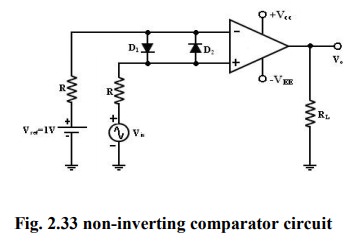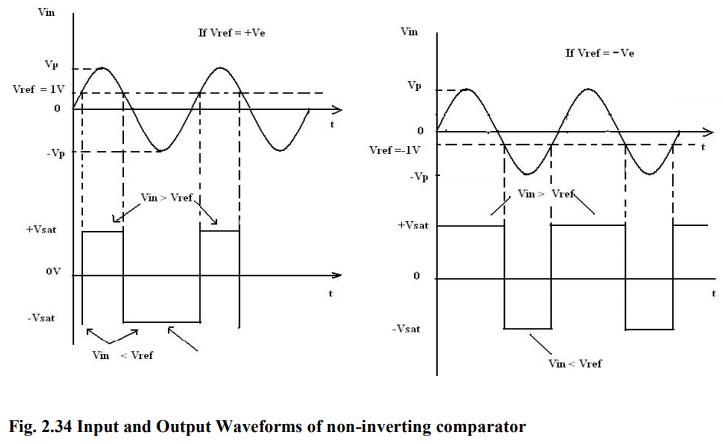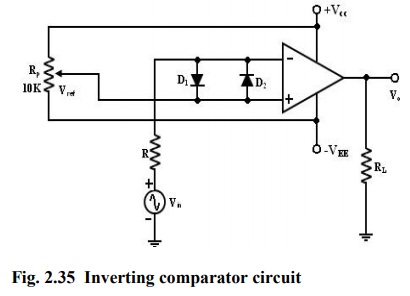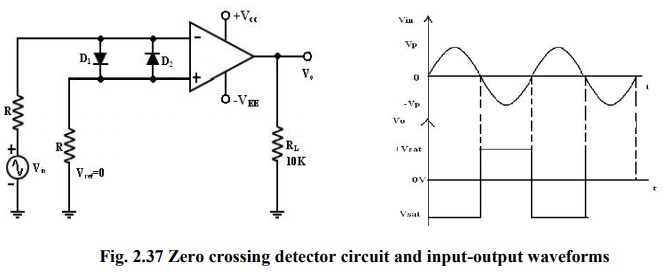Applications of Operational Amplifier - Comparator using Operational Amplifier | Linear Integrated Circuits : Applications of Operational Amplifier
Chapter: Linear Integrated Circuits : Applications of Operational Amplifier
Comparator using Operational Amplifier
Comparator
A
comparator compares a signal voltage on one input of an op-amp with a known
voltage called a reference voltage on the other input. Comparators are used in
circuits such as,
·
Digital
Interfacing
·
Schmitt
Trigger
·
Discriminator
·
Voltage
level detector and oscillators
Non-inverting
Comparator:

A
fixed reference voltage Vref of 1 V is applied to the negative
terminal and time varying signal voltage Vin is applied to the positive
terminal.
When
Vin is less than Vref the output becomes V0 at –Vsat
[Vin
< Vref => V0 (-Vsat)].
When
Vin is greater than Vref, the (+) input becomes positive, the V0
goes to +Vsat.
[Vin
> Vref => V0 (+Vsat)].
Thus
the V0 changes from one saturation level to another.
The
diodes D1 and D2 protect the op-amp from damage due to
the excessive input voltage Vin. Because of these diodes, the
difference input voltage Vid of the op-amp diodes are called clamp diodes.
The
resistance R in series with Vin is used to limit the current through
D1 and D2. To reduce offset problems, a resistance Rcomp
= R is connected between the (-ve) input and Vref.

Inverting Comparator:
This
fig shows an inverting comparator in which the reference voltage Vref
is applied to the (+) input terminal and Vin is applied to the (-)
input terminal.

In
this circuit Vref is obtained by using a 10K potentiometer that
forms a voltage divider with DC supply volt +Vcc and -1 and the
wiper connected to the input. As the wiper is moved towards +Vcc, Vref
becomes more positive. Thus a Vref of a desired amplitude and polarity can be
got by simply adjusting the 10k potentiometer.

Applications:
Zero Crossing Detector: [ Sine wave to Square wave converter]

One
of the applications of comparator is the zero crossing detector or ―sine wave
to Square wave Converter. The basic comparator can be used as a zero crossing
detector by setting Vref is set to Zero.
This
Fig shows when in what direction an input signal Vin crosses zero
volts. (i.e.) the o/p V0 is driven into negative saturation when the
input the signal Vin passes through zero in positive direction.
Similarly, when Vin passes through Zero in negative direction the output V0
switches and saturates positively.
Drawbacks of Zero- crossing detector:
In
some applications, the input Vin may be a slowly changing waveform, (i.e) a low
frequency signal. It will take Vin more time to cross 0V, therefore V0
may not switch quickly from one saturation voltage to the other.
Because
of the noise at the op-amp‘s input terminals the output V0 may fluctuate
between 2 saturations voltages +Vsat and –Vsat. Both of these problems can be
cured with the use of regenerative or positive feedback that cause the output
V0 to change faster and eliminate any false output transitions due to noise
signals at the input Inverting comparator with positive feedback This is known
as Schmitt Trigger.
Related Topics